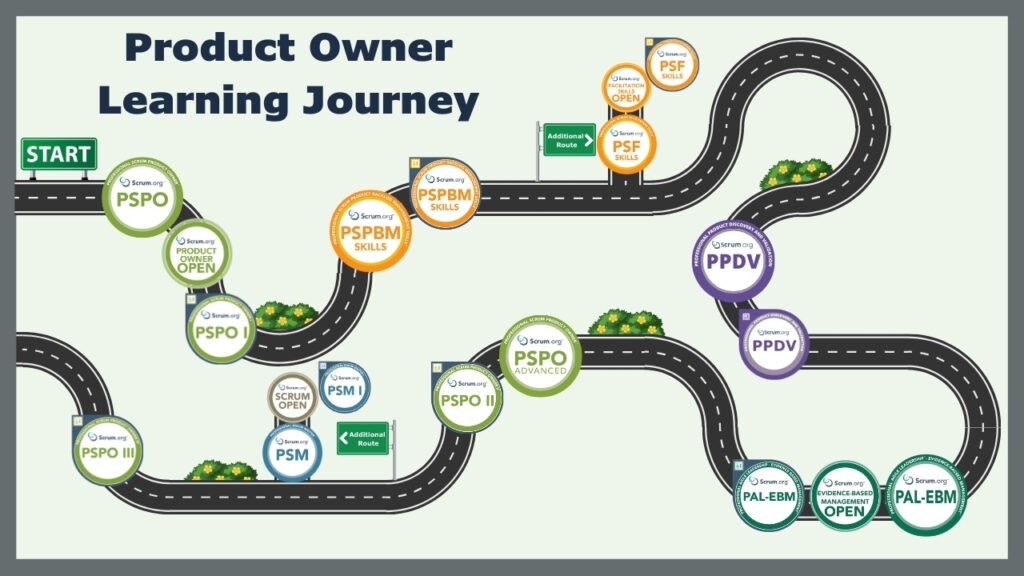If you are considering your path as a Product Owner and are unsure how to start, Scrum.org provides a clear roadmap to guide you through the learning journey. Becoming an effective Product Owner requires a deep understanding of Scrum, product strategy, and stakeholder management. Fortunately, Scrum.org offers structured certifications that help validate your expertise and progressively develop your skills.
You can find here step-by-step learning path for a Product Owner, explaining which certifications to take, when to take them, and how to prepare for each exam. Whether you’re just starting or looking to master advanced Product Ownership, this guide will help you navigate your journey with confidence.
Now, let’s dive into the Product Owner certification path and explore how to advance from a beginner to an expert-level Product Owner. 🚀

Step 1: Start with the Basics
Before diving into official certifications, it’s advisable to build a fundamental understanding of Scrum and the Product Owner role. Start with:
✅ Scrum.org Open Assessments (Free Practice Tests)
- Scrum Open
- Product Owner Open
These assessments help gauge your readiness for official certifications.
Step 2: Take the Entry-Level Certification – PSPO I
🔹 Certification: Professional Scrum Product Owner I (PSPO I)
🔹 Ideal for: Beginners who understand Scrum basics and want to validate their knowledge.
🔹 Exam Details:
- Cost: $200
- Passing Score: 85%
- Time Limit: 60 minutes
- Questions: 80 (Multiple Choice, Multiple Answer, True/False)
📌 Preparation:
- Read the Scrum Guide thoroughly.
- Take the Scrum Open and Product Owner Open assessments.
- Consider attending the Professional Scrum Product Owner (PSPO) course.
Step 3: Gain Practical Experience
After passing PSPO I, it’s recommended to spend some time applying Scrum principles in real-world projects before moving to advanced certifications.
You can explore additional knowledge areas such as:
- Professional Scrum Facilitation Skills (PSF Skills) for effective communication.
- Professional Scrum with Business Agility (PSPBM Skills) for business-focused agility.
🔹 Optional Certifications at This Stage:
- Professional Scrum Facilitation Skills (PSF Skills)
- Professional Scrum with Business Agility (PSPBM Skills)
These are beneficial for enhancing stakeholder engagement and business agility skills.
Step 4: Advance to PSPO II – For Experienced Product Owners
🔹 Certification: Professional Scrum Product Owner II (PSPO II)
🔹 Ideal for: Practicing Product Owners who want to deepen their skills in product strategy and stakeholder collaboration.
🔹 Exam Details:
- Cost: $250
- Passing Score: 85%
- Time Limit: 60 minutes
- Questions: 40 (Multiple Choice, Multiple Answer)
📌 Preparation:
- Gain real-world experience working as a Product Owner.
- Study advanced Scrum topics beyond just the Scrum Guide.
- Take the Professional Scrum Product Owner – Advanced course.
- Participate in Scrum.org communities and discussions.
Step 5: Expand Knowledge – Additional Learning Routes
At this stage, you can broaden your expertise by exploring related Scrum topics:
🔹 Optional Certifications:
- Professional Scrum Developer – PPDV (Understanding the development side of Scrum)
- Professional Agile Leadership – Evidence-Based Management (PAL-EBM) (For strategic and data-driven product decisions)
- Evidence-Based Management (EBM Open) (For performance metrics and value-driven decisions)
Step 6: Reach the Pinnacle – PSPO III
🔹 Certification: Professional Scrum Product Owner III (PSPO III)
🔹 Ideal for: Expert-level Product Owners who want to demonstrate mastery of complex Scrum applications.
🔹 Exam Details:
- Cost: $500
- Time Limit: 150 minutes
- Questions: 24 (Essay-style)
- Scoring: Pass/Fail (Manually graded)
📌 Preparation:
- Have at least 2-3 years of hands-on Product Owner experience.
- Be proficient in complex Scrum applications and product strategies.
- Engage in deep Scrum.org discussions and read advanced Scrum materials.
- Take advanced workshops like PSPO-A (Professional Scrum Product Owner – Advanced).
Final Thoughts
- If you’re new to Scrum, start with PSPO I and build experience.
- If you have real-world Scrum experience, advance to PSPO II.
- If you’re a highly skilled Product Owner, take PSPO III to showcase expertise.
I hope it help you to structure your learning path as a Product Owner.